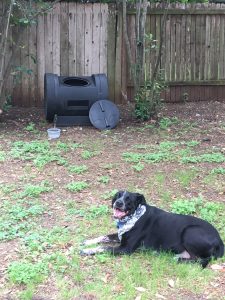Hi folks! For this week’s blog entry I wanted to share my recent journey into backyard composting to inform and possibly persuade some of you to look into trying it out yourselves! Here are some tips, tricks, my own learned lessons, and environmental implications you might benefit from if you’re looking to try your hand at composing.
An enviro-friendly benefit of composting includes reducing your methane footprint, as you’re diverting a lot of household waste that would otherwise be sent to the landfill. Additionally, by using your resulting compost in place of store-bought fertilizer you are avoiding excess nutrients and unknown chemicals from entering air/soil/water which enacts unintended effects on our surrounding environment.
There is a ton of information online that will supplement the intro tips I will outline but here’s how I have been going about this composting journey. One of the many websites I used in my research before starting this journey suggested you think of your composter like a pet or houseplant. You should practice feeding it the right ingredients, and remember to take care of it (at least) weekly. If you keep those good practices up you’ll have nutrient-rich soil that can be used to naturally fertilize your backyard garden or potted plants.
A look at the barrel-style composter that I scored second-hand at a yard sale for $20. This is just one of the many ways you can go about composting–just be sure to research beforehand to decide what method and medium are right for your lifestyle.
One important thing I learned when starting out is you want to ‘feed’ your pet composter a healthy even diet. Its diet should include equal parts ‘browns’, ‘greens’, and water. ‘Browns’ are usually high in carbon and carbohydrates, while ‘greens’ are usually high in nitrogen and proteins–all things that make for great compost. The carbon-rich materials help to prevent odors in your pile resulting from the breakdown of your greens as well as help to prevent leaching and evaporation of nitrogen.
- The very first thing I did before adding other materials, as toss in a good amount of old garden soil into the barrel as a base to add the browns and greens to mix into.
- Some ‘browns’ that I like to incorporate into my pile are:
- Browned/dead leaves (avoid oak tree leaves as they don’t break down quickly)
- Trimmings of dead houseplants (pruning your houseplants also keeps them healthy and happy–bonus!)
- Newspaper and cardboard (make sure to either shred or tear up into smaller pieces for the best results)
- And more!
*Note: Browns have been the hardest for me to keep up with but thankfully I found out newspaper has been a good supplement as I often have fewer dead leaves/trimmings.
- Some ‘greens’ that I like to incorporate into my pile are:
- Food scraps from fruits and veggies (usually my avocado skins, orange peels, banana peels, and trimmed veggie ends)
- Coffee grounds and tea leaves
- Egg shells
- And more!
*Note: Always avoid meat scraps, bones, and most dairy products as they don’t break down as easily and can introduce harmful bacteria and can even attract animals.
- Lastly, water hasn’t been an issue for me thus far as I’ve noticed my pile stays healthy with moisture. Should that change and I notice it appearing to dry out, I would consider adding a couple cups of water or lightly misting the mixture before rotating.
Most sites I found suggest you rotate or mix your compost once a week, but I’ve gotten into the habit of rotating my barrel more often than that when I’m adding new materials about every couple days. To ensure a more even breakdown of all the different materials, you can cut up your kitchen scraps and browns into smaller pieces which can speed up the process as well.
A closer photo of what my compost is looking like after just a couple weeks from when I started this journey.
This week I was noticing my ratio of greens was much higher so I supplemented by tearing up newspaper and mixing it into the pile.
Overall I highly suggest giving composting a try. I’ve been really surprised by how many things are compostable and just how easy it can be to set aside these otherwise landfill doomed materials. Since I’ve started getting into the swing of things I’ve noticed that I look forward to checking in on how things are progressing and I can’t wait to see how the soil inside turns out in a month or so. One last important tip: If I’m having a busy couple of days, I’ve learned that I can store my scraps in a container in the freezer until I have time to add them to the pile.
Hope this was helpful and convincing enough to try out on your own!





